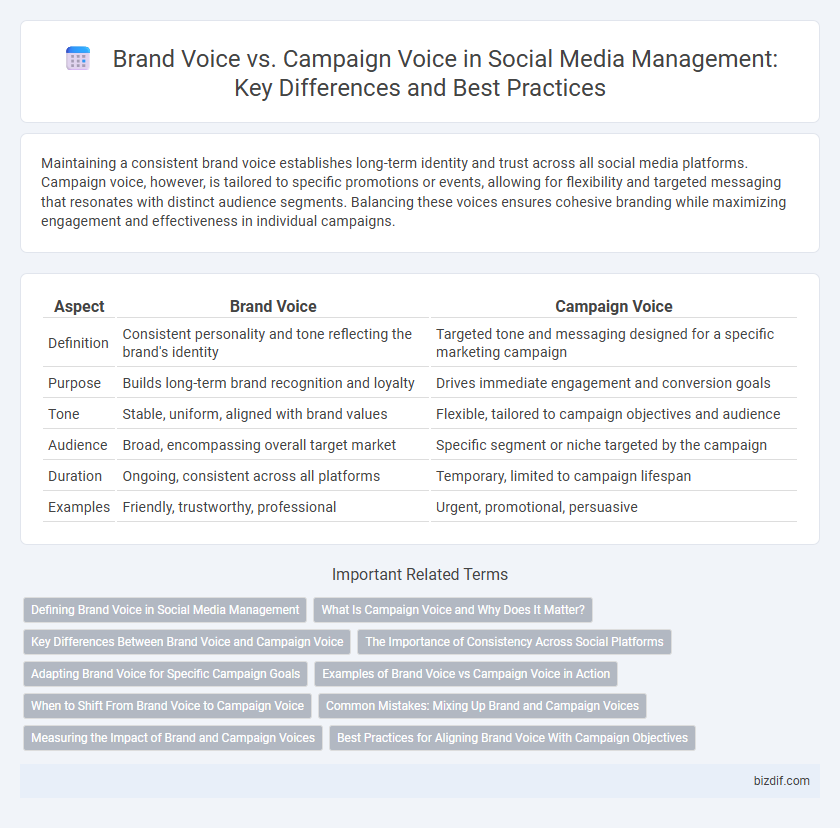Maintaining a consistent brand voice establishes long-term identity and trust across all social media platforms. Campaign voice, however, is tailored to specific promotions or events, allowing for flexibility and targeted messaging that resonates with distinct audience segments. Balancing these voices ensures cohesive branding while maximizing engagement and effectiveness in individual campaigns.
Table of Comparison
| Aspect | Brand Voice | Campaign Voice |
|---|---|---|
| Definition | Consistent personality and tone reflecting the brand's identity | Targeted tone and messaging designed for a specific marketing campaign |
| Purpose | Builds long-term brand recognition and loyalty | Drives immediate engagement and conversion goals |
| Tone | Stable, uniform, aligned with brand values | Flexible, tailored to campaign objectives and audience |
| Audience | Broad, encompassing overall target market | Specific segment or niche targeted by the campaign |
| Duration | Ongoing, consistent across all platforms | Temporary, limited to campaign lifespan |
| Examples | Friendly, trustworthy, professional | Urgent, promotional, persuasive |
Defining Brand Voice in Social Media Management
Defining brand voice in social media management establishes a consistent tone, style, and personality that reflects a company's core values and connects authentically with its target audience. This voice ensures all content aligns with the brand's identity, fostering trust and recognition across platforms. Differentiating brand voice from campaign voice helps maintain long-term engagement while allowing flexibility for specific marketing initiatives.
What Is Campaign Voice and Why Does It Matter?
Campaign voice refers to the specific tone, style, and language tailored to a particular marketing initiative, designed to resonate with the target audience and achieve precise objectives. It differs from brand voice by being more flexible and focused on the campaign's goals, ensuring consistent messaging across all channels during its duration. Understanding and implementing a clear campaign voice enhances audience engagement, strengthens brand identity, and drives the success of promotional efforts on social media platforms.
Key Differences Between Brand Voice and Campaign Voice
Brand voice represents the consistent personality and tone that defines a company's identity across all social media platforms, creating long-term brand recognition and trust. Campaign voice, however, is a targeted, temporary tone crafted to engage specific audiences and achieve distinct marketing goals during a particular promotion or event. The key differences lie in brand voice's stability and uniformity versus campaign voice's adaptability and focus on short-term messaging.
The Importance of Consistency Across Social Platforms
Maintaining consistency in brand voice across social platforms ensures a cohesive identity that fosters trust and recognition among audiences. Campaign voice may shift to suit specific marketing goals, but aligning it with the core brand tone prevents confusion and strengthens message clarity. Cohesive communication across channels maximizes engagement and reinforces the brand's unique value proposition dynamically.
Adapting Brand Voice for Specific Campaign Goals
Adapting brand voice for specific campaign goals ensures consistent messaging while resonating with targeted audiences. Tailoring tone, language, and style to fit campaign objectives increases engagement and strengthens brand identity. This strategic adjustment enhances connection without compromising the core brand personality across social media platforms.
Examples of Brand Voice vs Campaign Voice in Action
Brand voice embodies a consistent tone and personality across all social media channels, such as Wendy's witty and sarcastic style that reinforces its brand identity. Campaign voice shifts to match specific goals and audiences, like Nike's motivational and empowering tone during its "Just Do It" campaigns. This distinction ensures cohesive brand recognition while allowing tailored messaging to drive engagement and conversions.
When to Shift From Brand Voice to Campaign Voice
Shifting from brand voice to campaign voice occurs when targeting a specific audience segment or promoting a time-sensitive message that requires a distinct tone or style. Brand voice remains consistent across all communications to build long-term identity, while campaign voice adapts dynamically to emphasize urgency, product benefits, or emotional appeal linked to the campaign's goals. Recognizing key moments like product launches, special promotions, or crisis responses ensures strategic voice shifts enhance engagement and align with marketing objectives.
Common Mistakes: Mixing Up Brand and Campaign Voices
Mixing up brand and campaign voices often confuses audiences and dilutes brand identity, leading to inconsistent messaging across social media platforms. Brand voice remains constant, reflecting core company values and personality, while campaign voice shifts to suit specific goals and target audiences. Maintaining clear distinctions ensures effective communication and strengthens overall social media engagement.
Measuring the Impact of Brand and Campaign Voices
Measuring the impact of brand and campaign voices involves analyzing engagement metrics, sentiment analysis, and audience reach across social media platforms. Brand voice consistency strengthens long-term customer loyalty, while campaign voice effectiveness is often reflected in short-term spikes in conversions and interactions. Tools like social listening software and A/B testing help quantify how each voice influences brand perception and campaign success.
Best Practices for Aligning Brand Voice With Campaign Objectives
Maintaining consistency between brand voice and campaign voice enhances audience trust and recognition, crucial for effective social media management. Best practices include clearly defining your brand's core values and tone, then tailoring campaign messaging to reflect specific objectives while staying true to that overarching identity. Regularly monitoring audience feedback and engagement metrics ensures the campaign voice resonates without deviating from brand authenticity.
brand voice vs campaign voice Infographic

 bizdif.com
bizdif.com